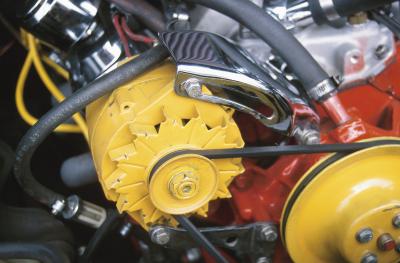
Engine drive belts that power the water pump, alternator and other accessories have several means of obtaining and keeping optimum tension. The methods and components employed for this task vary by engine design and manufacturer. Loose drive belts may fail to gain traction when the engine accelerates, or when the driven accessory is put under a load. Drive belts that are too tight can cause premature wear of the belt and accessory component pulley bearings.
Some applications use the belt-driven accessory as the tensioner. The alternator or power steering pump pivots on one attaching bolt, while another bolt passes through a slotted bracket. The bolts are loosened, and the accessory slides up or down the slot to tighten or loosen the belt. Some designs incorporate a threaded rod that forces the accessory away from the engine when turned clockwise. Turn the threaded rod counterclockwise to loosen or remove the belt.
Idler pulleys are combined with engine configurations to alter belt tension without moving any accessories. The pulley may be mounted in a slotted bracket and the pulley slides in the slot when the attaching bolt is backed off. Other idler pulleys may be mounted to a plate that has a pivot point and a raised boss to pry against. Tension is set by relocating the pulley and tightening the attaching bolt, or bolts.
An idler pulley that is specially constructed to maintain proper belt tension is often referred to simply as a belt tensioner, as it serves no other real purpose. A pulley is fastened to an arm that is under spring pressure. The back of the assembly has a boss or peg that fits into a cavity on the front of the engine. The spring pressure is constant and maintains tension continually as the belt wears and loads are applied.
Belt tensioners that use spring pressure usually have an indicator embossed into the pulley arm. A belt that has stretched or worn beyond limits is signified when the indicator aligns with marks on the tensioner, or mounting bracket. A belt-driven accessory that has been adjusted to either end of its travel may be a sign of belt wear, or incorrect size. Deflection of a belt between pulleys can be used to measure tension, but a belt tension gauge removes all doubt.